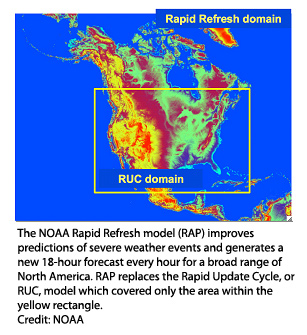NOAA has started using a new and sophisticated weather forecast model to improve predictions of quickly developing severe weather events, including thunderstorms, winter storms, and aviation hazards such as clear air turbulence. The improved model will also help with energy-related forecasting.
 The Rapid Refresh now provides NOAA’s most rapidly updated weather forecast, replacing an older model that served a similar function. The Rapid Refresh, developed by NOAA’s Earth System Research Laboratory in Boulder, Colo., and NOAA’s National Centers for Environmental Prediction (NCEP) in Camp Springs, Md., updates every hour with a new forecast extending 18 hours for North America. Such forecasts are especially important in aviation, where fast-developing weather conditions can affect safety and efficiency.
The Rapid Refresh now provides NOAA’s most rapidly updated weather forecast, replacing an older model that served a similar function. The Rapid Refresh, developed by NOAA’s Earth System Research Laboratory in Boulder, Colo., and NOAA’s National Centers for Environmental Prediction (NCEP) in Camp Springs, Md., updates every hour with a new forecast extending 18 hours for North America. Such forecasts are especially important in aviation, where fast-developing weather conditions can affect safety and efficiency.
The Rapid Refresh model extends the geographical coverage of NOAA’s weather situational awareness information to all of North America, not just the contiguous United States, as was the case for the older model.
The United States is the only country that updates computer model forecasts every hour using the latest observations from an extensive network of ground and satellite-based sensors, radars, and aircraft, said Stan Benjamin, lead developer of the new model and a research meteorologist at the Earth System Research Laboratory.
The new model was tested extensively, running experimentally for 22 months at NOAA’s NCEP, and will replace the older rapidly updated model, Rapid Update Cycle (RUC), which was run at similar frequency and resolution for an 18-hour forecast. In comparisons with the older model, the new Rapid Refresh (RAP) has proved more skillful.
For example, the new model performed significantly better than its predecessor in forecasting heavy rain that pounded the Midwest in June last year. The new forecasts more correctly projected the geographical areas that received 2 inches or more of precipitation.
RAP’s skillful forecasts derive from three key improvements over the earlier model:
RAP is based on a more advanced numerical weather prediction model, the Weather Research and Forecasting (WRF) model. WRF was created through a collaboration of NOAA, the National Center for Atmospheric Research, the Air Force Weather Agency, and dozens of other research institutions.
RAP uses an innovative technique for “assimilating” current observations to start the forecast model. The newer assimilation technique, developed through a NOAA-NASA research partnership led by NOAA’s NCEP, improves short-range forecasts.
RAP extends the geographical coverage of NOAA’s weather situational awareness information to all of North America, not just the contiguous U.S. as was the case for the older model.
NOAA
www.noaa.gov
Filed Under: Safety




